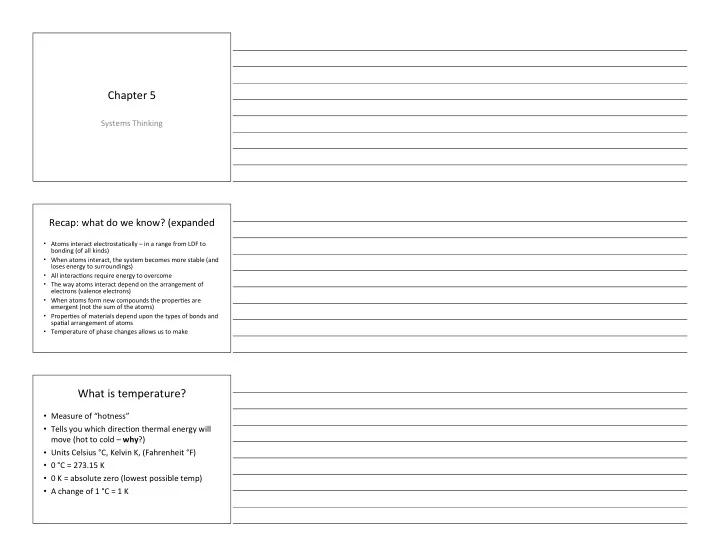

Chapter ¡5 Systems ¡Thinking Recap: ¡what ¡do ¡we ¡know? ¡(expanded ¡ • Atoms ¡interact ¡electrosta>cally ¡– ¡in ¡a ¡range ¡from ¡LDF ¡to ¡ bonding ¡(of ¡all ¡kinds) • When ¡atoms ¡interact, ¡the ¡system ¡becomes ¡more ¡stable ¡(and ¡ loses ¡energy ¡to ¡surroundings) • All ¡interac>ons ¡require ¡energy ¡to ¡overcome • The ¡way ¡atoms ¡interact ¡depend ¡on ¡the ¡arrangement ¡of ¡ electrons ¡(valence ¡electrons) • When ¡atoms ¡form ¡new ¡compounds ¡the ¡proper>es ¡are ¡ emergent ¡(not ¡the ¡sum ¡of ¡the ¡atoms) • Proper>es ¡of ¡materials ¡depend ¡upon ¡the ¡types ¡of ¡bonds ¡and ¡ spa>al ¡arrangement ¡of ¡atoms • Temperature ¡of ¡phase ¡changes ¡allows ¡us ¡to ¡make ¡ What ¡is ¡temperature? • Measure ¡of ¡“hotness” • Tells ¡you ¡which ¡direc>on ¡thermal ¡energy ¡will ¡ move ¡(hot ¡to ¡cold ¡– ¡ why ?) • Units ¡Celsius ¡°C, ¡Kelvin ¡K, ¡(Fahrenheit ¡°F) • 0 ¡°C ¡= ¡273.15 ¡K ¡ • 0 ¡K ¡= ¡absolute ¡zero ¡(lowest ¡possible ¡temp) • A ¡change ¡of ¡1 ¡°C ¡= ¡1 ¡K
Temperature ¡and ¡thermal ¡energy? • Thermal ¡energy ¡depends ¡on ¡how ¡much ¡ material ¡you ¡have ¡ – (eg ¡1 ¡drop ¡of ¡boiling ¡water ¡vs. ¡a ¡bucket ¡of ¡boiling ¡ water) – They ¡have ¡different ¡thermal ¡energies • Temperature ¡only ¡depends ¡on ¡the ¡average ¡KE ¡ – ¡so ¡1 ¡drop ¡or ¡a ¡bucket ¡of ¡boiling ¡water ¡s>ll ¡ have ¡the ¡same ¡T ¡– ¡but ¡different ¡amounts ¡of ¡ thermal ¡energy Temp ¡and ¡Kine>c ¡energy • T ¡is ¡ directly ¡related ¡to ¡ average ¡ kine>c ¡energy ¡ (1/2mv 2 ) • Can ¡an ¡individual ¡molecule ¡have ¡a ¡ temperature? ¡ • Do ¡all ¡the ¡molecules ¡move ¡at ¡the ¡same ¡speed ¡ at ¡a ¡given ¡temperature? ¡Why ¡not? Popula>ons ¡vs ¡individuals • At ¡the ¡molecular ¡scale ¡we ¡usually ¡consider ¡ popula>ons ¡(ie ¡a ¡lot ¡of ¡par>cles) • Popula>ons ¡of ¡molecules ¡can ¡have ¡a ¡ temperature ¡where ¡average ¡KE ¡= ¡3/2 ¡kT ¡ (where ¡k ¡is ¡a ¡constant) • ONE ¡molecule ¡can ¡have ¡a ¡KE ¡– ¡but ¡NOT ¡a ¡ temperature ¡ – Temperature ¡is ¡a ¡bulk ¡property
Ques>ons • What ¡happens ¡to ¡the ¡average ¡KE ¡(or ¡velocity) ¡as ¡ the ¡temperature ¡increases? • What ¡happens ¡to ¡the ¡average ¡KE ¡(or ¡velocity) ¡if ¡we ¡ compare ¡gases ¡of ¡different ¡molar ¡masses? ¡(does ¡a ¡ heavier ¡gas ¡move ¡faster ¡or ¡slower?) • When ¡molecules ¡collide ¡why ¡don’t ¡they ¡s>ck ¡ together? ¡ • The ¡average ¡speed ¡of ¡H 2 ¡molecules ¡is ¡2000m/s ¡at ¡ 273K ¡– ¡why ¡don’t ¡we ¡smell ¡things ¡immediately? Maxwell-‑Boltzmann ¡distribu>on ¡for ¡a ¡ Which ¡is ¡at ¡ the ¡highest ¡ T? A. Red B. Green C. Blue What ¡about ¡for ¡different ¡gases ¡at ¡the ¡ same ¡T? At ¡a ¡given ¡temperature ¡the ¡average ¡KE ¡
Maxwell-‑Boltzmann ¡distribu>on ¡for ¡different ¡ gases ¡at ¡the ¡same ¡temperature ¡(Ne, ¡Ar, ¡Kr) Which ¡Kr? A. Red B. Green C. Blue Boltzmann • KE ¡= ¡1/2mv 2 ¡ = ¡3/2kT • k ¡= ¡Boltzmann’s ¡constant • hep://people.chem.byu.edu/rbshirts/ research/boltzmann_3d • (for ¡a ¡monatomic ¡gas) Energy ¡of ¡mo>on KE ¡– ¡normally ¡associated ¡with ¡ movement ¡ (transla>on) But ¡there ¡are ¡other ¡forms ¡of ¡movement ¡eg ¡ vibra>on ¡and ¡ ¡rota>on ¡that ¡are ¡important ¡ for ¡more ¡complex ¡materials
Energy ¡of ¡Mo>on ¡ Phase Transla>on Rota>on Vibra>on Gas Free Free Free Liquid Restricted Less ¡free ¡than ¡gas Free Solid Absent Very ¡limited Free Heat ¡and ¡Thermal ¡Energy • Thermal ¡energy ¡– ¡energy ¡associated ¡with ¡ mo>on ¡of ¡par>cles ¡(Joules) • Heat ¡– ¡strictly ¡the ¡transfer ¡of ¡thermal ¡energy ¡ from ¡one ¡place ¡to ¡another ¡(eg ¡by ¡collisions ¡of ¡ molecules) ¡– ¡ – Can ¡tell ¡which ¡way ¡it ¡is ¡transferred ¡by ¡the ¡ temperature ¡(hot ¡-‑-‑> ¡cold) Specific ¡heat/heat ¡capacity • How ¡much ¡energy ¡it ¡takes ¡to ¡change ¡the ¡ temperature ¡of ¡a ¡substance. • Specific ¡heat ¡– ¡energy ¡required ¡to ¡raise ¡1 ¡g ¡by ¡ 1 ¡°C ¡(or ¡1 ¡K) • Molar ¡heat ¡capacity ¡– ¡energy ¡required ¡to ¡raise ¡ 1 ¡mol ¡by ¡1 ¡°C ¡(or ¡1 ¡K) ¡
Name Formula Molar ¡mass Molar ¡heat ¡ Specific ¡heat ¡ (g/mol) capacity ¡(J/ ¡mol ¡ (J/g ¡°C) water H 2 O 18 75.4 4.18 methanol CH 3 OH 32 81 2.53 ethanol CH 3 CH 2 OH 48 112 2.44 propanol CH 3 CH 2 CH 2 OH 60 144 2.39 If ¡you ¡add ¡the ¡same ¡amount ¡of ¡thermal ¡energy ¡to ¡each ¡of ¡ these, ¡which ¡one ¡would ¡increase ¡in ¡temperature ¡most? Propanol What ¡do ¡you ¡no>ce ¡about ¡the ¡specific ¡heat ¡values ¡ shown? So ¡why ¡is ¡water ¡so ¡much ¡higher?
Recommend
More recommend